Author(s): Areeba Saeed, Sohaib Imtiaz and Samreen Riaz*
As per National cancer Institute (NCI), malignant growth alludes to any of an enormous number of sicknesses portrayed by the advancement of irregular cells that isolate wildly and be able to invade and decimate typical body tissue (Figure 1.1). Threatening development much of the time can spread all through your body. Malignant growth is the subsequent driving reason for death universally, representing an expected 9.6 million passings, or one of every six passing, in 2018 (CDC, 2018)
At the point when malignant growth grows, be that as it may, this efficient procedure separates. As cells become increasingly unusual, old or harmed cells endure when they should pass on, and new cells structure when they are not required. These extra cell can parcel interminably and may shape improvements called tumors. A tumor might be harmful or generous.
In contrast to threatening tumors, considerate tumors don’t spread into, or attack, close by tissues. Benevolent tumors can here and there be very huge, be that as it may. At the point when expelled, they for the most part don’t develop back, while harmful tumors now and again do. Dissimilar to most kind tumors somewhere else in the body, generous cerebrum tumors can be hazardous.
Harmful tumors are dangerous, which implies they can spread into, or attack, close by tissues. What’s more, as these tumors develop, some disease cells can sever and make a trip to removed spots in the body through the blood or the lymph framework and structure new tumors a long way from the first tumor. Just dangerous tumors are appropriately alluded to as malignancy. The difference between benign and malignant tumor are shown in figure 1.2 [1].
Pathologically, malignancies are arranged into three classifications: Carcinomas, Sarcomas, Leukemia
This sort of malignancy emerges from epithelial cells or ectodermal tissues covering the inward surface of the different organs. For instance: bosom malignant growth, lung disease, skin malignant growth, mind disease, malignancy of pancreas and mouth, throat, stomach and digestive tract.
These malignancies emerge from connective and strong tissue got from mesoderm. For models: bone tumors, muscle tumors, muscle tumors, malignant growth of lymph hubs.
It is the dangerous development of leucocytes (WBC). People influenced with this malignancy show the unreasonable creation of leucocytes (blood disease) and malignancy of bone marrow. Furthermore, cerebrum tumor, kidney tumor and eye tumor (melanoma) is found in newborn children and kids because of threatening development of crude early stage tissues. Correspondingly, cervical disease is basic in ladies and prostate malignancy normal in men [2].
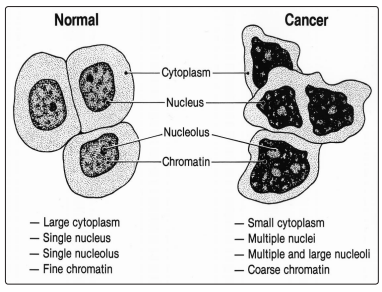
Figure 1.1: comparison of normal and cancer cell structure (National Cancer Institute) https://visualsonline.cancer.gov/details.cfm?imageid=2512
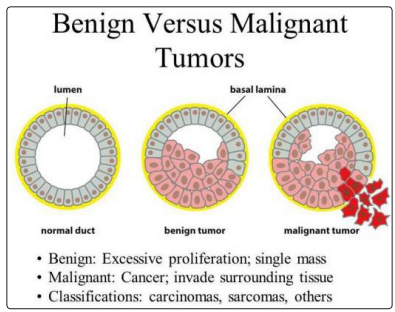
Figure 1.2: Difference between benign and malignant tumors
https://www.slideshare.net/AnamikaOf/benign-malignant-growth-pathologyThe admonition indications of malignant growth have been viewed as a powerful method to sum up early indications of disease into
a usable and vital correspondence to people in general. It is recognized that endurance from numerous sorts of malignant growth is
essentially improved if treatment is begun at a beginning phase and early discovery relies somewhat upon individuals having the
information to perceive the notice signs [3].
When all is said in done the malignancy signs are depicted beneath (Figure 1.3):
• Unusual draining or release
• A change in mole size
• Nausea
• Numbness
• Formation of bump on body
• A pestering hack
• Headache
• Tiredness
• Unexplained weight reduction
• Changes in bladder propensities
• Recurring contaminations which won’t clear with common treatment
• A sore that doesn’t mend
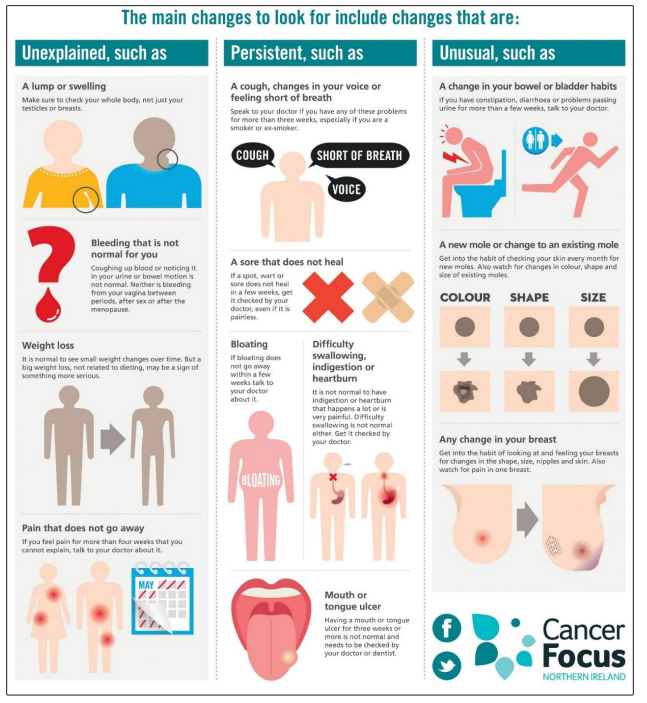
Figure 1.3: Common Sign and symptoms of cancer in Adults
https://cancerfocusni.org/cancer-info/signs-symptoms/signs-symptoms-of-cancer-infographic/The rundown underneath incorporates the most-examined known or suspected hazard factors for malignant growth. Constraining your introduction to avoidable hazard elements may bring down your danger of building up specific malignant growths [4]. Distinctive hazard factors are liable for various kinds of malignant growth as appeared in table 1.1. A portion of these variables are clarified beneath
Nickel mixes, cadmium, arsenic, nitrosamines, trichloroethylene, arylamines, benzopyrene, aflatoxin, receptive O2 radicals and many mores.
• UV beams (bright), ionizing radiation (x-beams and gamma beams)
Certain infections and microscopic organisms
Viruses:
• Virus has additionally been related with different sorts of
malignant growths. These infections are called oncoviruses.
• Rous sarcoma infection (RSV) is the main found retro-infection
causing malignant growth.
• (Oncovirus); Human papilloma infection (HPV), EpsteinBarrVirus, (EBV), Hepatitis B infection, Herpes infection
• Hepatitis B and C infection is calmly related with hepato-cell
carcinoma.
• Cytomegalovirus (CMV) is related with kaposi’s sarcoma.
• Human papilloma infection (HPV) is a central suspect of cervix
malignancy.
Helicobacter pylori, E. coli, Pseudomonas, S. aureus and so forth.
Mutations, change in DNA replication, metabolic responses creating, receptive oxygen radicals, Immune framework surrenders, Aging [5].
| Cancer Type | Risk factors |
|---|---|
| Breast | Radiation Genetic changes (inherited mutation) |
| Lung | Tobacco smoke, Asbestos and other substances Air pollution |
| Prostate | Diet, certain prostate changes Race Africans Americans |
| Colorectal | Cancer polyp Genetic alteration Diet, smoking |
| Liver | Hepatitis virus (HBV, HCV) |
| Pancreas | Smoking, diabetes, Being male |
| Kidney | Tobacco smoking High blood pressure |
| Leukemia | Radiation chemotherapy Certain diseases (Down syndrome) Human T-cell leukemia virus |
| Bladder | Occupation certain infection Use tobacco Arsenic exposure |
| Uterine | Endometrial hyperplasis Hormone replacement therapy Obesity |
| Melanoma | Weakened immune system Fai skin severe blistering/sunburn UV radiation |
The most significant hazard factor for malignancy is becoming more seasoned. Most malignant growths happen in individuals beyond 55 years old, yet disease can happen in more youthful ages also. Both malignant growth and maturing come about because of collecting harm to the stem and begetter cells. Certain hereditary changes influence the undifferentiated cells to partition crazy which lead to disease.
Ordinary substantial cells telomere misfortunes are combined with expanding age of the living being. Because of transformations in the TERC and TERT telomerase qualities, telomeres will abbreviate in human untimely maturing disorder and dyskeratosis inborn. Ecological factors, for example, stress, economic wellbeing, smoking and heftiness can likewise quicken telomere shortening because of diminished telomerase action. Rather than typical physical cells, most human tumors have enacted telomerase to accomplish unfading development [7].
Most malignant growths create on account of hereditary changes. Some hereditary changes that expansion the danger of malignant growth are passed from parent to youngster. Specific kinds of malignant growth do happen more regularly in certain families than in the remainder of the populace, for example, colon disease. Familial adenomatous polyposis (FAP) is a genuine case of innate colon malignancy. Individuals with FAP may have more than hundred polyps in their colon. In the event that it is untreated, one of these polyps will create to malignant growth.
The APC quality is related with this disorder ought to be inspected for hereditary transformation. Evacuating the polyps by early medical procedure will upgrade the recuperation. Another acquired disorder that expands colon malignancy is inherited non-polyposis colorectal disease (HNPCC) or Lynch condition. Individuals with this condition have a higher danger of colorectal disease [8].
Tobacco use is the most preventable reason for death. Every year, in excess of 180,000 Americans bite the dust from disease because of smoking. Over 85% of all lung tumors and 30% of all passings are brought about by smoking. Recycled smoke can likewise increment 5% the danger of disease. Smokers and liquor clients are almost certain than nonsmokers to create various sorts of malignant growths, for example, lung, larynx, mouth, throat, bladder, kidney, throat, stomach, pancreas, cervix and intense myeloid leukemia as appeared in figure 1.4. Smoking likewise adds to cardiovascular, cerebrum stroke, aspiratory, innate distortions and unexpected newborn child demise condition. Among 4000 synthetic substances that have been distinguished in tobacco smoke, at any rate 400 are known to be destructive to human wellbeing, for example, hydrogen cyanide, carbon monoxide, and smelling salts. Practically 10% of these harmful synthetic compounds are demonstrated to be cancer-causing, for example, arsenic, benzene, chromium, ethylene oxides, nickels, polonium, vinyl chlorides, formaldehydes, benzopyrene, toluenes [9].
Liquor utilization causes 3.6 % of every human malignancy. Having multiple beverages every day for a long time will build the opportunity of creating malignancies of the mouth, throat, throat, stomach, liver, colon, lymphomas, prostate, kidney, bosom and ovaries. Liquor has been arranged by World Health Organization (WHO) as gathering 1-cancer-causing agent. Liver can process 7 grams of ethyl liquor every hour.
At the point when liver procedures liquor, it will deliver acetaldehyde which is cancer-causing. Higher presentation to acetaldehyde will incite a deformity in liquor dehydrogenase quality and tumor silencer quality (BRCA) inactivation that can prompt the upper gastrointestinal tract, bosom and liver malignant growths. Iron collection, retinoic corrosive debilitation, acetaldehyde genotoxicity, expanded estrogen fixation, free extreme creation and folate metabolic modifications are instigated by interminable liquor misuse. Liver cirrhosis caused when liver cells are supplanted with scars because of interminable liquor use. Nearly 5% of individuals with cirrhosis lead to liver malignancy. The hazard is 35% higher for consumers with synchronous smoking propensities [10].
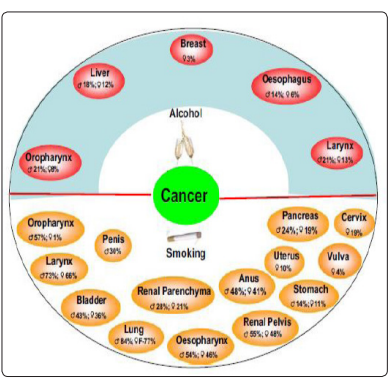
Figure 1.4: Alcohol and smoking associated mortality in men and women (Irigaray et al., 2007).
Bright (UV) radiation originates from the sun, sunlamps, and tanning corners. It causes early maturing of the skin that can prompt skin malignant growth. You additionally ought to shield yourself from UV radiation which can infiltrate light attire, windshields, and windows. Wear long sleeves, long jeans, a cap and shades with focal points that ingest UV. Sunscreen (Sun Protection Factor) can forestall skin malignancy. Avoid sunlamps and tanning stalls. They are not more secure than daylight.
Three kinds of sun radiations incorporate the noticeable (shading),
infrared (warmth) and UV lights. The UV-light from sun and
tanning can cause skin harms, for example, kind, pigmentation,
staining, spots, burn from the sun, tumors (Basal cell carcinoma,
Squamous carcinoma and Melanoma) and annihilation of elastin
and collagen proteins. Introduction to UV daylight delivers a
similar skin harms in winter just as late spring. Skin harms could
be diminished and/or forestalled by:
Irresistible miniaturized scale creatures have been assessed to cause 18% of all disease cases. The weight of malignancies brought about by contaminations is a lot more prominent in creating countries (27%) than in created countries (9%).
• Human Papilloma-Virus: HPV disease is the fundamental driver of cervical malignancy. Contamination with an oncogenic strain of HPV is viewed as a vital occasion for ensuing cervix malignancy, and immunization gave insusceptibility brings about a stamped decline in precancerous sores.
• Hepatitis B and Hepatitis C Viruses: Both infections can cause liver disease.
• Human T-cell leukemia/lymphoma infection 1 (HTLV-1): Infection with HTLV-1 expands an individual’s danger of lymphoma and leukemia.
•Human Immunodeficiency Viruses: HIV is the infection that causes AIDS. Individuals who have HIV disease are at extraordinary danger of lymphoma and Kaposi’s sarcoma malignant growths.
•Epstein-Barr Viruses: Infection with EBV has been connected to Burkitt’s lymphoma
•Human Herpesvirus-8 (HHV8): This infection is a principle chance factor for Kaposi’s sarcoma malignant growth.
•Helicobacter Pylori: This bacterium can cause stomach ulcers that can prompt MALT-lymphoma in the stomach and esophageal malignancy.
•Salmonella Typhi: This bacterium can cause gallbladder disease.
•Streptococcus Bovis: This bacterium can cause colon malignancy.
Estrogen and progestin are hormones that may expand the danger of bosom and uterus malignant growths, coronary failure, stroke, or blood clusters. Diethylstilbestrol (DES), is a type of estrogen, was given to some pregnant ladies in the United States somewhere in the range of 1940 and 1971. Ladies who took DES during pregnancy demonstrated a higher danger of creating bosom and ovarian malignant growths. Best instances of hormonal treatment drugs in oncology are tamoxifen and aromatase inhibitors (letrozole and anastrozole) which more prevalent than tamoxifen for bosom malignant growth treatment. At the point when the capacity of aromatase is repressed, estrogen creation decreases immensely in post-menopaused ladies which stops cell expansion. Likewise, steroid hormones can initiate quality articulation in the core of disease cells which lead to diminished hormonal creation and resulting cell development capture [13].
Individuals who have a less than stellar eating routine with decreased physical action might be at expanded danger of a few infections. Hefty individuals will be at higher danger of coronary illness, stroke, hypertension, diabetes, and tumors (throat, bosom, uterus, colon, rectum and prostate). Stoutness can be determined by Body Mass Index (BMI) by separating an individual’s weight (in kilograms) by their stature (in meters) squared. Fat tissue creates high amount of estrogen which is connected to expanded danger of malignant growths. Additionally, large individuals may deliver high measure of insulin-like development factor-1 (IGF1) in their blood which may prompt certain tumors (Figure 1.5).
Leptin and adiponectin are delivered by fat cells which can advance and repress cell expansion, separately. Aflatoxins are normally made mycotoxins which are created by Aspergillus (growth). Two of the most widely recognized ones are Aspergillus flavus and Aspergillus parasiticus which are harmful and cancercausing. Hepatic disappointment is showed by discharge, edema, changes in modification in assimilation and retention, trailed by mental changes and unconsciousness. In any event 14 unique kinds of aflatoxins are delivered in nature. Aflatoxin can intercalate with chromosome DNA base sets through its epoxide moiety. These progressions can cause hereditary transformations in the p53 quality. Ordinarily, this quality can forestall cell cycle movement when there are DNA changes or apoptosis. The codon 249 of the p53 quality is by all accounts defenseless to aflatoxin causing transformation than other codon. Ordinary eating regimen including vegetables lessens the cancer-causing impacts of aflatoxins [14].
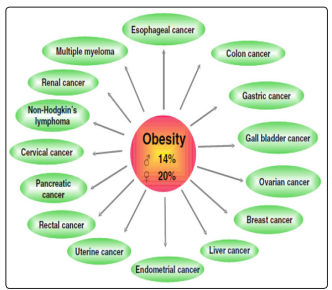
Figure 1.5: Different cancers that can be linked to obesity (Calle et al., 2003)
Disease trouble ascends to 18.1 million new cases and 9.6 million malignancy passings in 2018. Comprehensively, around 1 of every 6 passings is because of malignancy. The guides uncover considerable worldwide assorted variety in driving disease types, especially for frequency and mortality among ladies by nation (6 sorts). Figure 1.6 (a) and (b) portrays the most widely recognized kinds of diseases expected to be analyzed and cause mortality among ladies in 2018 [16].
Malignancies of the lung, women bosom, and colorectal are the best three disease types as far as frequency, and are positioned inside the best five regarding mortality (first, fifth, and second, separately). Together, these three malignant growth types are liable for 33% of the disease occurrence and mortality trouble around the world. Breast disease is the most ordinarily analyzed malignant growth in ladies (24.2%, for example around one of every 4 of all new disease cases analyzed in ladies overall are bosom malignancy), and the malignant growth is the most widely recognized in 154 of the 185 nations remembered for GLOBOCAN 2018. Bosom malignancy is additionally the main source of disease demise in ladies (15.0%), trailed by lung disease (13.8%) and colorectal disease (9.5%), which are likewise the third and second most regular sorts of disease, separately; cervical malignancy positions fourth for both frequency (6.6%) and mortality (7.5%) as appeared in figure 1.7.
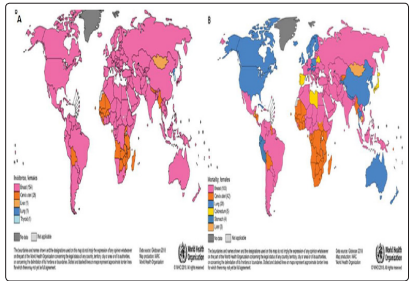
Figure 1.6: (A): Global maps presenting the most common type of cancer incidence in 2018 in each country among females. (B): Global maps presenting the most common type of cancer mortality by country in 2018 among females. (GLOBOCAN, 2018)
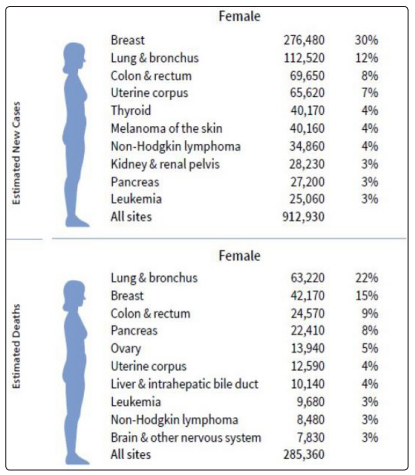
Figure 1.7: Estimated new cases and deaths for 10 leading cancer types among female [17].
As per the U.S. Habitats for Disease Control and Prevention the
five most normal malignant growths among ladies are:
• Breast
• Lung
• Colorectal
• Endometrial
• Thyroid Cancer
As per American establishment of disease research, bosom
malignant growth was the most well-known disease in ladies
around the world, contributing 25.4% of the absolute number of
new cases analyzed in 2018. The main three - bosom, colorectal
and lung malignant growths - contributed 43.9% all things
considered (barring non-melanoma skin disease). Cervical disease
was the fourth most normal malignancy in ladies, contributing
6.9% of the all-out number of new cases analyzed in 2018 [18].
Bosom malignancy is the most as often as possible analyzed disease and the main source of malignancy related demise among ladies around the world, representing 25% of malignancy cases and 15% of malignant growth related passing. Worldwide bosom malignant growth occurrence designs reflect both hazard factors and the accessibility and utilization of mammography. Death rates mirror the event of the sickness just as the accessibility of early identification and treatment.
Built up factors that expansion bosom disease hazard include: Being a lady Breast disease is around multiple times more typical in ladies than in men. Age: Two out of three ladies with obtrusive bosom malignant growth are 55 or more seasoned.
Your hazard is multiplied if your mom, sister, or little girl has had bosom malignant growth. Your hazard is significantly increased if two close family members have had it. “Screening rules shift somewhat dependent on family ancestry, so converse with your PCP about what’s best for you,” McFarland says.
Between 5 and 10 percent of bosom tumors are believed to be brought about by explicit quality transformations that are innate, with BRCA1 and BRCA2 being the most well-known changes connected to the ailment.
White ladies are more powerless to bosom malignant growth than African-Americans, yet African-American ladies are bound to pass on from bosom disease, somewhat on the grounds that their tumors may become quicker and show up at a further developed stage.
More stringy and glandular tissue as opposed to progressively greasy tissue - because old enough, menopausal status, certain medications, pregnancy, and hereditary qualities - can build bosom malignancy hazard up to twofold and can make envisioning early diseases on a mammogram increasingly troublesome.
Women who were recently rewarded for another malignant growth have a higher danger of bosom disease, especially in the event that they got the treatment when their bosoms were all the while creating.
A more noteworthy than normal number of menstrual periods (beginning of feminine cycle before age 12, beginning of menopause after age 55) somewhat raises hazard.
Insignificantly raises in general hazard, however pregnancy may build the danger of explicit bosom malignancy subtypes, similar to significantly increase negative illness.
The degree of hazard seems to return to typical 10 years after a lady quits taking the pill, be that as it may. Past treatment with diethylstilbestrol (DES), a medication once used to forestall unnatural birth cycle, gently raises bosom malignant growth hazard.
Avoiding this treatment diminishes your danger of bosom
malignant growth.
Not breastfeeding may marginally expand bosom disease chance.
(Especially after menopause) builds chance. McFarland says that working with a nutritionist to perceive how you can alter your eating routine may assist you with getting more fit and diminish that chance. What’s more, shedding pounds can diminish the measure of estrogen; bosom malignancy benefits from estrogen, and this hormone is progressively abundant in individuals who are stout.
Has been connected to a higher danger of bosom malignancy, so in case you’re generally inactive, mean to move more. “You can’t turn out badly with work out,” says McFarland. “We’re drawing near to having more information about that, and everything appears to be extremely reassuring.”
Compared with nondrinkers, ladies who have one beverage for every day are at a little expanded danger of bosom malignant growth, while ladies who have a few beverages for each day have a 20 percent higher danger of building up the malady, as per ACS.
Its utilization has additionally been attached to bosom malignant growth, however specialists aren’t sure on the off chance that it can really cause the infection, McFarland says. Consider eating increasingly white meat and fish in case you’re in danger [20].
Bosom malignant growth is treated in a few different ways. It relies upon the sort of bosom malignancy and how far it has spread. Individuals with bosom malignant growth frequently get more than one sort of treatment as appeared in figure 1.8.
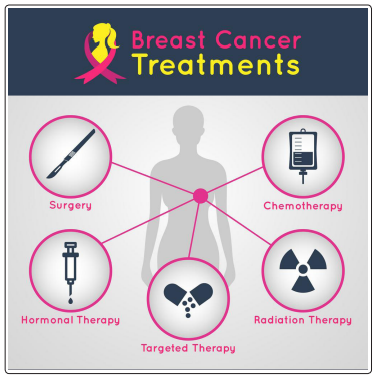
Figure 1.8: Different methods of breast cancer treatment https://www.vectorstock.com/royalty-free-vector/breast-cancertreatment-icon-infographics-vector-17117698
As per the American Cancer Society (ACS), lung malignant growth is the second most regular sort in guys and females, not including skin disease. For both genders, it is the main source of malignant growth related demise.
The American Lung Association report that lung malignant growth rates have diminished by 35% in guys in the course of the most recent 41 years, however the rates in females have increased by 87%.
• Brevity of breath
• Wheezing
• Roughness
• Exhaustion
• Tenacious, exacerbating hack
• Trouble gulping
• Lost craving
• Weight reduction
• Progressing chest torment
• Hacking up blood
• Intermittent lung diseases, for example, pneumonia or
bronchitis
The hazard factors for lung malignant growth are comparable
among guys and females. They include:
• Cigarette smoking
• Exposure to used smoke
• Exposure to asbestos, smoke, or radon
• A family ancestry of lung malignant growth
• An individual history of lung ailment, including lung
malignant growth
• A horrible eating routine [21].
KRAS is a quality, and any transformation in it might cause destructive tumors to develop all the more rapidly. A transformation may likewise make the tumors bound to spread. The audit recommends that KRAS transformations may make lung malignancy development increasingly forceful after introduction to estrogen, a female sex hormone, just as different hormones.
The audit partners gastric-discharging peptide receptor (GRPR) movement with disease cell development. This receptor is progressively dynamic in females, and presentation to estrogen may expand its belongings.
The correct medicines for lung malignant growth rely upon the disease’s phase at conclusion. A specialist can frequently expel little tumors that have not spread. A few specialists may prescribe chemotherapy or radiation treatment to help medical procedure and ensure that no harmful cells remain. In the event that the lung malignant growth has spread fundamentally, medical procedure is normally impossible. At this stage, a specialist may in any case prescribe radiation treatment to help control inconveniences and decrease torment and distress [22].
Colorectal malignant growth is one of the most widely recognized diseases in the two people. As indicated by the American Cancer Society, colorectal disease is the third most normally analyzed malignant growth in the two ladies and men. In spite of the fact that the hazard is somewhat lower for ladies than men, around 1 of every 24 U.S. ladies are in danger of building up this malignancy.
Indications of colon disease in ladies will in general be equivalent
to those found in men, and can include (Figure 1.9):
• Constipation, looseness of the bowels, or different changes
in gut propensities
• Blood in stool or rectal dying
• Abdominal torment or issues
• An impression that your entrails hasn’t purged totally
• Unexplained weight reduction
• Fatigue, shortcoming, or diminished vitality level
Hazard will in general ascension fundamentally after the period of 50Trusted Source, however more youthful individuals can create colon disease, as well.
In the event that you’ve had kindhearted polyps previously, you face higher dangers of dangerous polyps framing later on. Having had colon malignancy likewise puts you at a higher danger of another destructive polyp shaping.
Having a parent, kin, or other close relative with colon disease or a background marked by polyps makes you bound to create colon malignant growth.
On the off chance that you’ve gotten radiation treatment to treat tumors in the stomach zone, including cervical disease, you might be at a higher hazard for colon or rectal malignant growth.
Being inactive or corpulent, smoking, and drinking liquor unreasonably all can raise your hazard. Ladies are encouraged to have close to one mixed beverage for every day [23].
In its beginning phases, colon malignant growth might be treated by basically expelling the harmful polyps. At the point when the illness advances, more tissue or parts of the colon may should be expelled.
During chemotherapy, an amazing synthetic, frequently managed through an IV, slaughters disease cells. It’s regularly suggested if the malignancy has arrived at the lymph hubs. Some of the time chemotherapy is begun before medical procedure to help recoil the tumor or tumors.
During radiation treatment, incredible vitality bars, for example, X-beams, are focused on harmful tumors to shrivel or devastate them. Radiation treatment is here and there done related to chemotherapy, and might be prescribed preceding medical procedure.
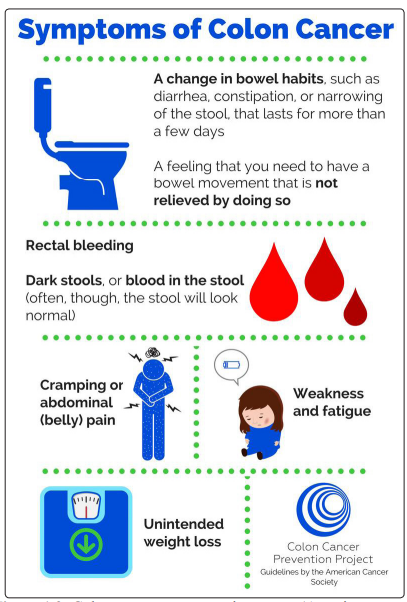
Figure 1.9: Colon cancer symptoms in women (American cancer society).
It is the fifth Leading Cause of Cancer-Related Death Among ladies. Endometrial malignant growth is a kind of disease that starts in the uterus. The uterus is the empty, pear-formed pelvic organ where fetal advancement happens. Endometrial malignant growth starts in the layer of cells that structure the covering (endometrium) of the uterus. Endometrial disease is now and then called uterine malignant growth. Different sorts of disease can shape in the uterus, including uterine sarcoma, however they are significantly less basic than endometrial malignant growth.
Numerous side effects are there to perceive endometrial malignancy
as appeared in figure 1.10.
• Abnormal vaginal draining or release, which happens in
nine out of 10 ladies with endometrial malignant growth.
Prior to menopause, this implies uncommonly substantial
unpredictable menstrual periods or seeping between periods.
After a lady enters menopause, this implies any vaginal
dying, except if she is on hormone substitution treatment
(HRT). Despite the fact that HRT may cause vaginal seeping
in postmenopausal ladies, the primary scenes of any such
draining ought to be checked by a specialist to ensure that it
isn’t because of endometrial malignancy. In any case, just 15%
of ladies with postmenopausal draining will have endometrial
malignant growth.
• Vaginal release that may run from pink and watery to thick,
earthy colored, and putrid. • Difficult or agonizing pee.
• An amplified uterus, noticeable during a pelvic test.
• Pain during intercourse.
• Unexpected weight reduction.
• Weakness and agony in the lower mid-region, back, or legs.
This happens when the disease has spread to different organs
[25].
Components that expansion the danger of endometrial disease
include:
• Changes to be determined of female hormones in the body. The
ovaries make two principle female hormones - estrogen and
progesterone. Vacillations to be decided of these hormones cause
changes in the endometrium. An ailment or condition that builds
the measure of estrogen, however not the degree of progesterone,
in your body can expand your danger of endometrial malignancy.
Models incorporate unpredictable ovulation designs, which may
occur in polycystic ovary condition, stoutness and diabetes. Taking
hormones after menopause that contain estrogen however not
progesterone expands the danger of endometrial disease.
An uncommon sort of ovarian tumor that secretes estrogen likewise can build the danger of endometrial disease.
The most well-known kinds of treatment for ladies with
endometrial malignancy are:
• Surgery
• Radiation treatment
• Chemotherapy
• Hormone treatment
• Directed treatment
• Immunotherapy
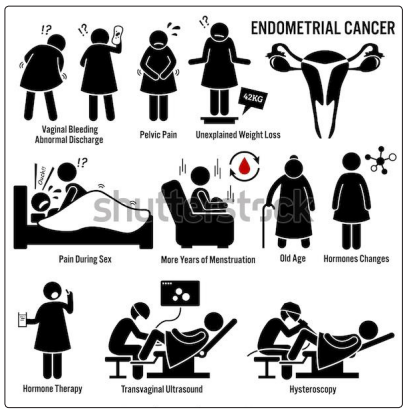
Figure 1.10: Common sign and symptoms of endometrial cancer
https://www.shutterstock.com/image-vector/endometrial-cancersymptoms-causes-risk-factors-361152332
Thyroid knobs (developments), influence up to 80 percent of ladies, however just 5 percent to 15 percent of those knots and knocks are harmful. Better testing implies thyroid tumors are on the ascent, he notes, saying that it’s anticipated to turn into the third most regular malignant growth.
Thyroid disease happens in the cells of the thyroid- a butterflymolded organ situated at the base of your neck, just underneath your Adam’s apple. Your thyroid produces hormones that direct your pulse, circulatory strain, internal heat level and weight.
Thyroid malignant growth ordinarily doesn’t cause any signs or
side effects right off the bat in the malady. As thyroid disease
develops, it might cause:
• A protuberance (knob) that can be felt through the skin on
your neck
• Changes to your voice, including expanding riskiness
• Difficulty gulping
• Pain in your neck and throat
• Swollen lymph hubs in your neck
Variables that may expand the danger of thyroid malignant growth
include:
• Female sex. Thyroid disease happens more frequently in
ladies than in men.
• Exposure to significant levels of radiation. Radiation treatment
medicines to the head and neck increment the danger of
thyroid disease.
• Certain acquired hereditary conditions. Hereditary conditions
that expansion the danger of thyroid malignancy incorporate
familial medullary thyroid disease, numerous endocrine
neoplasia, Cowden’s disorder and familial adenomatous
polyposis.
The treatment alternatives for thyroid disease may include:
• Surgery
• Radioactive Iodine (Radioiodine) Therapy
• Thyroid Hormone Therapy
• External Beam Radiation Therapy
• Chemotherapy
• Targeted Drug Therapy [27].
A urinary tract contamination, or UTI, is a disease in any piece of your urinary framework, which incorporates our kidneys, bladder, ureters, and urethra. A ladies’ possibility of getting a urinary tract contamination is high. A few specialists rank your lifetime danger of getting one as high as 1 out of 2, with numerous ladies having rehash contaminations, in some cases for a considerable length of time. Around 1 of every 10 men will get an UTI in the course of their life.
The manifestations of an UTI can incorporate (Figure 1.11):
• A consuming inclination when you pee
• A visit or serious desire to pee, despite the fact that little
comes out when you do
• Cloudy, dull, wicked, or abnormal smelling pee
• Feeling drained or flimsy
• Fever or chills (a sign that the contamination may have arrived
at your kidneys)
• Pain or weight in your back or lower mid-region
You may feel like you have to pee a great deal, or it may hurt when you pee. You may likewise have lower stomach agony and shady or ridiculous pee.
PYELONEPHRITIS (kidney7): This can cause fever, chills, sickness, spewing, and torment in your upper back or side.
The accompanying components can improve the probability of
building up an UTI:
• Sexual intercourse, particularly if progressively visit, serious,
and with numerous or new accomplices
• Diabetes
• Poor individual cleanliness
• Problems discharging the bladder totally
• Having a urinary catheter
• Bowel incontinence
• blocked stream of pee
• Kidney stones
• Some types of contraception
• Pregnancies
• Menopause
• Procedures including the urinary tract
• Suppressed resistant framework
• Immobility for an extensive stretch
• Use of spermicides and tampons
• Heavy utilization of anti-microbials, which can disturb the
common verdure of the inside and urinary tract [29].
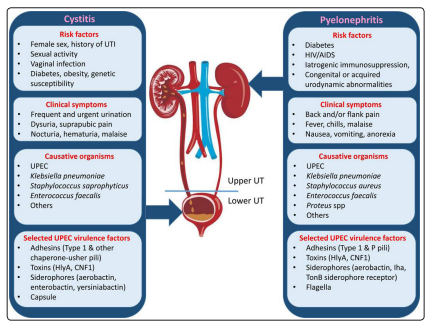
Figure 1.11: Common features and clinical complications of UTI (McLellan & Hunstad, 2016)
Contaminations come about because of climbing colonization of the urinary tract, fundamentally by existing vaginal, perineal, and fecal verdure. Different maternal physiologic and anatomic elements incline to climbing disease. Such factors incorporate urinary maintenance brought about by the heaviness of the broadening uterus and urinary balance because of progesterone-incited ureteral smooth muscle unwinding. Blood-volume development is joined by increments in the glomerular filtration rate and urinary yield. Loss of ureteral tone joined with expanded urinary tract volume brings about urinary balance, which can prompt dilatation of the ureters, renal pelvis, and calyces. Urinary balance and the nearness of vesicoureteral reflux incline a few ladies to upper urinary tract contaminations (UTIs) and intense pyelonephritis [31].
There are a few estimates that can be taken to lessen the danger
of building up an UTI:
• Drink heaps of water and pee as often as possible.
• Avoid liquids, for example, liquor and caffeine that can disturb
the bladder.
• Urinate soon after sex.
• Wipe from front to back subsequent to peeing and solid
discharge.
• Keep the genital territory clean.
• Showers are liked to showers and abstain from utilizing oils.
• Sanitary cushions or menstrual cups are liked to tampons.
On the off chance that you need to purchase menstrual cups,
at that point there is an astounding choice on Amazon with
a large number of client audits.
• Avoid utilizing a stomach or spermicide for anti-conception
medication.
• Avoid utilizing any perfumed items in the genital territory.
• Wear cotton clothing and baggy apparel to keep the region
around the urethra dry
Treatment with antimicrobials means to destroy the microscopic organisms causing disease. The picked antimicrobials rely upon degree of contamination (straightforward or muddled), normal nearby pathogens, and opposition designs. Instances of antiinfection agents for simple UTI include:
Restraint of microbial DNA combination by blocking DNA gyrase and topoisomerase IV required for fruitful DNA replication and translation.
The system isn’t completely seen, yet it legitimately makes specific harm microbial DNA, which processes the poisonous intermediates of nitrofurantoin more quickly than human cells [32].
Malignant growth is the second reason for death close to cardiovascular infections around the world. The most well-known area and most noteworthy death rate have a place with pneumonic disease in men and bosom malignant growth in ladies. The International Agency for Research on Cancer (IARC) announced the most widely recognized malignant growths in both genders are aspiratory, bosom, colorectal, prostate, and gastric diseases. Disease is a consistent and critical issue in malignancy patients because of numerous elements that expansion the defenselessness of immunosuppressed malignant growth patients to contamination, for example, neutropenia during chemotherapy, modified gut vegetation in light of regular anti-microbial organization, and interruption of skin and harm of epithelial surfaces of the tissues by cytotoxic chemotherapeutic operators.
Urinary tract disease is a genuine medical issue in the network and medicinal services settings. Malignancy patients are at high danger of urinary contaminations because of disease chemotherapy prompts extreme and delayed immunosuppression, for example, neutropenia during chemotherapy, changed gut greenery on account of continuous anti-toxin organization, and interruption of skin and harm of epithelial surfaces of the tissues by cytotoxic chemotherapeutic operators. Because of this, it is a genuine medical issue that includes bacterial attack and duplication in the organs of the urinary tract framework, and it is a typical issue for patients to visit outpatient offices. In spite of the far reaching accessibility of anti-infection agents, urinary tract disease stays an overall remedial issue
In immunocompromised malignant growth patients, urinary tract contamination (UTI) is one of the significant reasons for fever and grimness. Screening for UTI is significant as atypical introduction isn’t extraordinary in such patients. As indicated by Cancer Research in UK the quantity of ladies who have had bosom malignancy and create urinary tract diseases or cystitis is somewhere in the range of 5 and 8 out of 100 (5 to 8%). On the off chance that you have diabetes or a prolapsed bladder your danger of building up these issues is marginally higher. Clinically, UTIs are classified as simple or confused. Simple UTIs ordinarily influence people who are in any case sound and have no auxiliary or neurological urinary tract variations from the norm, these contaminations are separated into lower UTIs (cystitis) and upper UTIs (pyelonephritis).
UTIs are bought about by both Gram-negative and Gram-positive microbes, just as by specific growths. The most well-known causative specialist for both straightforward and entangled UTIs is uropathogenic Escherichia coli (UPEC). For the operators engaged with straightforward UTIs, UPEC is followed in predominance by Klebsiella pneumoniae, Staphylococcus saprophyticus, Enterococcus faecalis, bunch B Streptococcus (GBS), Proteus mirabilis, Pseudomonas aeruginosa, Staphylococcus aureus and Candida spp. For entangled UTIs, the request for commonness for causative specialists, following UPEC as generally normal, is Enterococcus spp., K. pneumoniae, Candida spp., S. aureus, P. mirabilis, P. aeruginosa and Group B streptococcus [33].
Bacterial diseases customarily have not been viewed as significant reasons for malignant growth. As of late, be that as it may, microscopic organisms have been connected to disease by two components: enlistment of constant aggravation and creation of cancer-causing bacterial metabolites. Irresistible specialists, for example, hepatitis B (HBV) and C infections (HCV), EpsteinBarr infection (EBV), human papillomavirus (HPV), human immunodeficiency infection type 1 (HIV-1), E.coli, Staphylococcus aureus, Helicobacter pylori (H. pylori) and Streptococcus bovis (S. bovis) add to the pathogenesis of various diseases.
A past filled with urinary tract disease can be considered as a hazard factor for bladder malignant growth. Escherichia coli (E. coli) disease is answerable for 70% of urinary tract contamination. Bladder disease is a typical harm, around the world; it is the seventh most pervasive disease, representing 3.2% everything being equal. A significant factor in the turn of events and movement of bladder malignant growth is urinary tract diseases (UTIs) including bacterial, parasitic, contagious, and viral contaminations; urinary lithiasis and pelvic radiation. Microorganisms are the essential driver of UTIs, with most by far (70-80%) credited explicitly to disease with E. coli. A repetitive topic in the connection between bacterial disease and carcinogenesis is that of interminable irritation, which a typical component of steady contamination is frequently. E. coli contamination in the bladder tissues expands the cancer-causing capacity of nitrosamine antecedents (Figure 1.12). Three components were recommended to represent the tumor upgrading impact of E. coli in the test. In the first place, E. coli contamination of bladder tissues builds the cancer-causing capacity of nitrosamine forerunners and this might be because of increment of nitrite creation by the microbes and ceaseless creation of nitrosoamine by aiding in-situ nitrosamine blend. Second, E. coli contamination quickened urothelial multiplication. This may have increased the mutagenic impact of the cancer-causing agent. Third, drawn out oxidative and nitrosative burdens which brings about DNA harm and change [34].
As of late, H. Pylori was pronounced by the International Agency for Research on Cancer (IARC) to be a Group 1 cancer-causing agent, a positive reason for human malignancy. H. pylori disease mounts a ceaseless fiery reaction more than a very long while zone may bring about mitotic mistakes. Destructiveness factors like cytotoxin-related quality A (CagA) and vacuolating cytotoxin A (VacA) have been demonstrated to be related with precancerous gastric sores and movement to a threatening phenotype. Contamination with H. pylori causes incessant irritation and essentially expands the danger of creating duodenal and gastric ulcer illness and gastric disease. Disease with H. pylori is the most grounded realized hazard factor for gastric malignant growth,which is the subsequent driving reason for disease related passings around the world [35].
One of the bacterial operators that has been seen as normally connected with colorectal malignant growth is Streptococcus bovis (S. bovis). S. bovis has been appeared to have significant effect on wellbeing since 25 to 80% of patients with S. bovis bacteremia have colorectal tumors and the occurrence of relationship of colonic neoplasia with S. bovis endocarditis has been demonstrated to be 18 to 62%. It was indicated that 94% of S. bovis bacteremia related with colorectal malignancy was in reality S. bovis biotype I while just 18% was related with biotype II. Afterward, another species looking like S. bovis was identified which was named S. gallolyticus. Strikingly, S. bovis biotype I and II/2 secludes were then seen as S. gallolyticus [36].
Among other microorganisms, Salmonella typhi and Streptococcus bovis have been associated with being related with gallbladder carcinoma and colorectal malignant growth, individually (Table 1.2). The industrious disease of erythrocytes and endothelial cells with Bartonella can trigger angiogenesis and lead to vascular tumor development in people, and Chlamydophila pneumoniae has been associated with being related with lung malignancy [37].
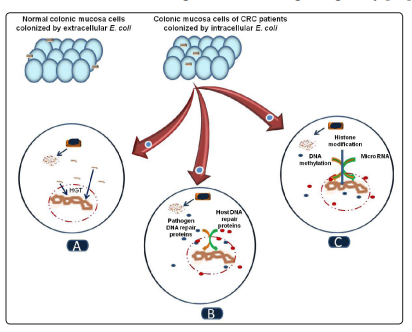
Figure 1.12: Proposed clarification for the possible contribution of E. coli mutY in CRC etiology. During constant E. coli contamination, the microscopic organisms set up an intracellular habitation in related colon malignant growth cells. (A) Shedding of the bacterial DNA into the host cell and because of arrangement homology among mutY and MUTYH, level quality exchange occasions may happen, which can prompt the advancement of CRC. (B) Products of E. coli mutY and human MUTYH can likewise influence the capacity of DNA fix in have cell (C) Epigenetic controllers of the bacterial mutY quality can likewise influence human MUTYH prompting strange articulation of MUTYH and at last the advancement of CRC (Khan and Cash, 2013).
| Bacteria | Associated cancer |
|---|---|
| E.coli | Colon cancer |
| Helicobacter pylori | Gastric cell carcinoma |
| Salmonella typhi | Gall bladder carcinoma |
| Streptococcus bovis | Colon cancer |
Urinary tract contamination (UTI) is one of the most widely recognized irresistible maladies and the primary driver of network obtained and nosocomial diseases at affirmation. Patients with UTI generally present with intense clinical UTI or constant simple or convoluted UTI. Convoluted UTI include people with a condition or progressively safe pathogen that expands the danger of bombing treatment with practical, metabolic, or auxiliary variations from the norm. Irritation/inflammation is a principle factor in disease advancement, however concentrates on the connection among UTI and malignant growth dangers are inadequate Figure 1.13. Also, the UTI frequency in ladies is a lot higher than that in men, however the dominant part are basic or straightforward UTI that happen in sound or nonpregnant ladies. Lower UTI incorporates cystitis and prostatitis, and upper UTI incorporate pyelonephritis. The Infectious Diseases Society of America watched an UTI commonness of 1%-5% in solid and premenopausal ladies and 1.9%-9.5% in pregnant ladies. Side effects of lower urinary tract are normal in men, and the commonness increments with age. Up to 90% of men matured 50-80 years may experience the ill effects of inconvenient lower urinary tract manifestations [40].

Figure 1.13: Bacteria inflammation causes cancer
In this way, numerous antimicrobial treatments, incorporating
treatment with various anti-infection agents were done among UTI
patients. Following anti-microbials are utilized for UTI related
malignant growth patients [41].
• Trimethoprim
• Ciprofloxacin
• Levofloxacin
• Cephalexin
• Cephalosporins
• Doxycycline
• Nitrofurantoin
• Amoxicillin/Clavulanate
• Ceftazidime
Aggravation is a primary factor in malignancy advancement, yet concentrates on the connection among UTI and disease dangers are insufficient. An ongoing report exhibited a connection among UTI and genitourinary tumors (GUC) and affirmed that intermittent UTI are a hazard factor for urinary bladder malignant growth. Additionally, the connection among UTI and different tumors is significant in light of the fact that UTI-caused provocative reaction is a foundational manifestation. What’s more, UTI can be analyzed based on a blend of manifestations and a positive pee examination or culture. Consequently, various antimicrobial treatments, incorporating treatment with cephalosporin, quinolone, ampicillin, beta-lactam, amoxicillin, nitrofurantoin, sulfamethoxazole, and trimethoprim, can be endorsed. Along these lines, utilizing antiinfection agents is essential for UTI treatment. In spite of the fact that proof for the connection among UTI and malignant growth dangers is uncommon, it is sensible to conjecture that UTI issue may in any case lead to diseases, particularly GUC. Along these lines, utilizing an across the country database, this examination explored the relationship among UTI and anti-microbial use affecting the danger of malignant growth [42-48].
The prevalence of urinary tract infection has been increasing in the past few years and its prevalence is greater in women than men. This infection has become very common and prevalent in Pakistani population among patients suffering from cancer as well. Urinary tract infection is very common and became complicated among cancer patients as compared to non- cancer patients. So the main focus of the study was to find the complication of urinary tract infection in female cancer patients. The main purpose of the study is to determine the pathogens that cause urinary tract infections in cancer patients and to determine the resistance and sensitivity pattern of pathogens against different antibiotics. If untreated, UTI can become a serious health issue. In this study, we have identify the microorganisms which are responsible for causing urinary tract infection in female cancer patients. We can also determine the factors which are responsible for increasing the risk of UTI in females. The biochemical testing was doe to characterize the isolated strains from UTI patients. The resistance and sensitivity pattern of microorganisms causing urinary tract infection in female cancer patients against different antibiotics can also be checked by this study. We evaluated physical and biochemical parameters too of normal and cancer female patients.
